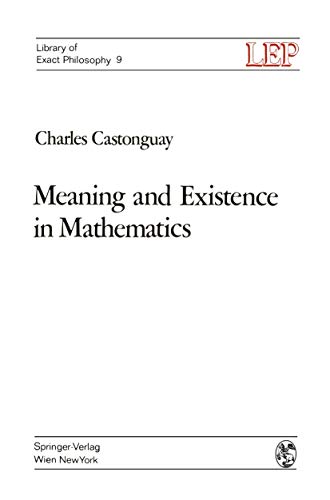Verwandte Artikel zu Meaning and Existence in Mathematics: 9 (LEP Library...

Inhaltsangabe
The take-over of the philosophy of mathematics by mathematical logic is not complete. The central problems examined in this book lie in the fringe area between the two, and by their very nature will no doubt continue to fall partly within the philosophical re mainder. In seeking to treat these problems with a properly sober mixture of rhyme and reason, I have tried to keep philosophical jargon to a minimum and to avoid excessive mathematical compli cation. The reader with a philosophical background should be familiar with the formal syntactico-semantical explications of proof and truth, especially if he wishes to linger on Chapter 1, after which it is easier philosophical sailing; while the mathematician need only know that to "explicate" a concept consists in clarifying a heretofore vague notion by proposing a clearer (sometimes formal) definition or formulation for it. More seriously, the interested mathematician will find occasional recourse to EDWARD’S Encyclopedia of Philos ophy (cf. bibliography) highly rewarding. Sections 2. 5 and 2. 7 are of interest mainly to philosophers. The bibliography only contains works referred to in the text. References are made by giving the author’s surname followed by the year of publication, the latter enclosed in parentheses. When the author referred to is obvious from the context, the surname is dropped, and even the year of publication or "ibid. " may be dropped when the same publication is referred to exclusively over the course of several paragraphs.
Die Inhaltsangabe kann sich auf eine andere Ausgabe dieses Titels beziehen.
Reseña del editor
The take-over of the philosophy of mathematics by mathematical logic is not complete. The central problems examined in this book lie in the fringe area between the two, and by their very nature will no doubt continue to fall partly within the philosophical re mainder. In seeking to treat these problems with a properly sober mixture of rhyme and reason, I have tried to keep philosophical jargon to a minimum and to avoid excessive mathematical compli cation. The reader with a philosophical background should be familiar with the formal syntactico-semantical explications of proof and truth, especially if he wishes to linger on Chapter 1, after which it is easier philosophical sailing; while the mathematician need only know that to "explicate" a concept consists in clarifying a heretofore vague notion by proposing a clearer (sometimes formal) definition or formulation for it. More seriously, the interested mathematician will find occasional recourse to EDWARD'S Encyclopedia of Philos ophy (cf. bibliography) highly rewarding. Sections 2. 5 and 2. 7 are of interest mainly to philosophers. The bibliography only contains works referred to in the text. References are made by giving the author's surname followed by the year of publication, the latter enclosed in parentheses. When the author referred to is obvious from the context, the surname is dropped, and even the year of publication or "ibid. " may be dropped when the same publication is referred to exclusively over the course of several paragraphs.
„Über diesen Titel“ kann sich auf eine andere Ausgabe dieses Titels beziehen.
EUR 55,00 für den Versand von Frankreich nach USA
Versandziele, Kosten & DauerNeu kaufen
Diesen Artikel anzeigenEUR 13,78 für den Versand von Vereinigtes Königreich nach USA
Versandziele, Kosten & DauerSuchergebnisse für Meaning and Existence in Mathematics: 9 (LEP Library...
Meaning and Existence in Mathematics (LEP Library of Exact Philosophy)
Anbieter: Ria Christie Collections, Uxbridge, Vereinigtes Königreich
Zustand: New. In. Artikel-Nr. ria9783709171158_new
Anzahl: Mehr als 20 verfügbar
Meaning and existence in Mathematics - library of Exact Philosophy 9
Anbieter: crealivres, La fontennelle, Frankreich
Zustand: Good. Envoi rapide Bon état cependant premier plat taché dans le coin supérieur intérieur frais. in8. 1972. Cartonné. Good. Artikel-Nr. 100083608
Anzahl: 1 verfügbar
Meaning and Existence in Mathematics
Anbieter: Revaluation Books, Exeter, Vereinigtes Königreich
Paperback. Zustand: Brand New. 176 pages. 9.25x6.10x0.40 inches. In Stock. Artikel-Nr. x-3709171156
Anzahl: 2 verfügbar
Meaning and Existence in Mathematics
Anbieter: AHA-BUCH GmbH, Einbeck, Deutschland
Taschenbuch. Zustand: Neu. Druck auf Anfrage Neuware - Printed after ordering - The take-over of the philosophy of mathematics by mathematical logic is not complete. The central problems examined in this book lie in the fringe area between the two, and by their very nature will no doubt continue to fall partly within the philosophical re mainder. In seeking to treat these problems with a properly sober mixture of rhyme and reason, I have tried to keep philosophical jargon to a minimum and to avoid excessive mathematical compli cation. The reader with a philosophical background should be familiar with the formal syntactico-semantical explications of proof and truth, especially if he wishes to linger on Chapter 1, after which it is easier philosophical sailing; while the mathematician need only know that to 'explicate' a concept consists in clarifying a heretofore vague notion by proposing a clearer (sometimes formal) definition or formulation for it. More seriously, the interested mathematician will find occasional recourse to EDWARD'S Encyclopedia of Philos ophy (cf. bibliography) highly rewarding. Sections 2. 5 and 2. 7 are of interest mainly to philosophers. The bibliography only contains works referred to in the text. References are made by giving the author's surname followed by the year of publication, the latter enclosed in parentheses. When the author referred to is obvious from the context, the surname is dropped, and even the year of publication or 'ibid. ' may be dropped when the same publication is referred to exclusively over the course of several paragraphs. Artikel-Nr. 9783709171158
Anzahl: 1 verfügbar

